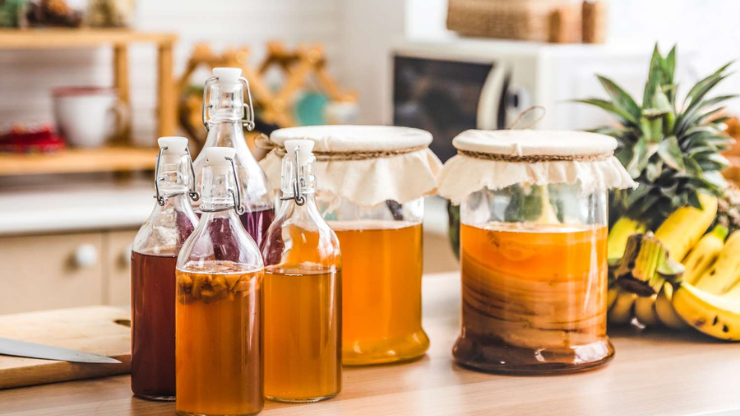How to Make Kombucha – Are you looking to delve into the world of probiotic-rich beverages? Learn how to make Kombucha at home and unlock many health benefits and flavors. This comprehensive guide will take you through the step-by-step process of crafting this fizzy, tangy, and nutrient-packed drink, empowering you to embark on a journey of delicious and gut-friendly experimentation.
Table of Contents
ToggleHow to Make Kombucha: A Step-By-Step Guide
Here, you will learn everything about making two kinds of Kombucha, Continuous Brew Kombucha and Chai chai-flavored kombucha. So, let’s start our journey of How to Make Kombucha.
Step By Step Guide To Make Continuous Brew Kombucha
Here is a step-by-step guide to make continuous brew Kombucha:
Step 1: Set Up Your Continuous Brew System
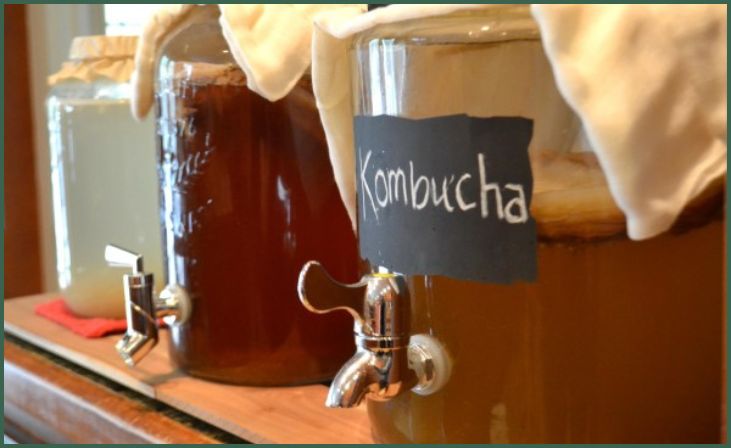
- Choose a large glass jar or vessel with a spigot for easy dispensing.
- Ensure the jar is thoroughly cleaned and sanitized to prevent contamination.
Step 2: Prepare the Sweet Tea Base
- Boil water and add the desired amount of sugar, typically one cup per gallon of water.
- Steep the tea bags or loose tea in the hot water for 15-20 minutes.
- Allow the sweet tea to cool to room temperature before proceeding.
Step 3: Introduce the Starter Liquid and SCOBY
- Pour a portion of the matured Kombucha liquid into the jar as the starter.
- Gently place the SCOBY (Symbiotic Culture of Bacteria and Yeast) into the jar.
Step 4: Initiate the Continuous Fermentation Process
- Cover the jar with a breathable cloth or paper towel secured with a rubber band.
- Put the jar somewhere warm and airy that isn’t in direct sunlight.
- Allow the Kombucha to ferment for 7-21 days, depending on taste preferences.
Step 5: Monitor the Fermentation Progress
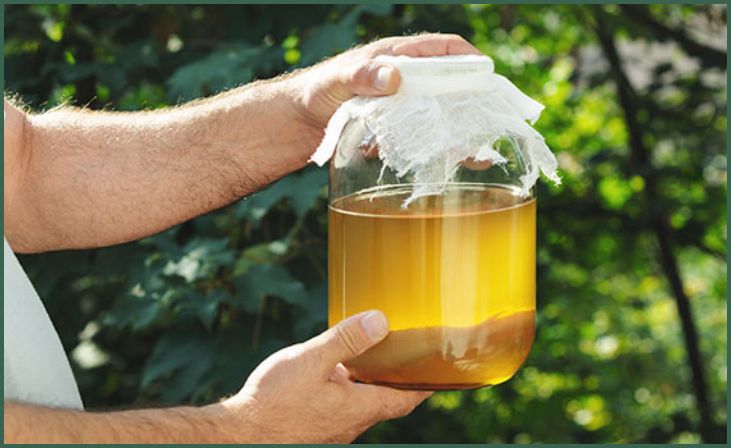
- Check the taste and acidity level of the Kombucha regularly using a straw or a clean spoon.
- Maintain the desired level of tartness by adjusting the brewing time according to your preference.
Step 6: Harvest and Refill
- Once the Kombucha reaches the desired flavor, use the spigot to dispense the finished brew.
- Retain a portion of the matured liquid along with the SCOBY for the next batch.
- Refill the jar with the sweet tea mixture, repeating the process from Step 2.
Step 7: Regular Maintenance and Hygiene
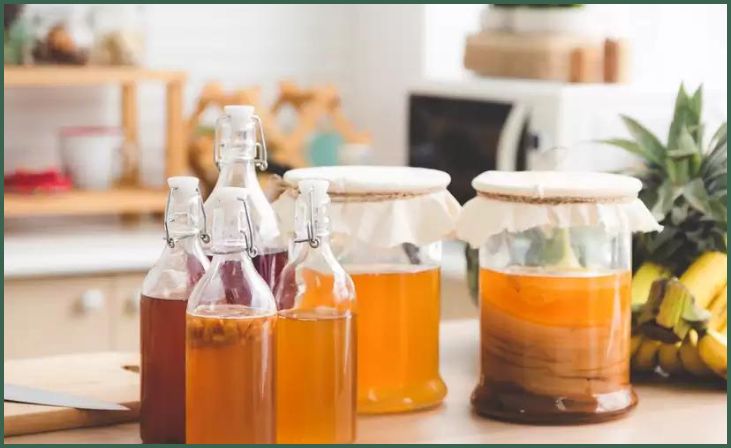
- Clean the spigot and the container regularly to prevent any contamination or mold growth.
- Inspect the SCOBY for any signs of discoloration or mold and remove any anomalies promptly.
Step 8: Experiment with Flavors and Secondary Fermentation
- After harvesting the Kombucha, consider experimenting with various fruit, herbs, or spices for secondary fermentation.
- Transfer the brewed Kombucha to airtight bottles, adding flavoring ingredients as desired.
- Allow the bottles to sit at room temperature for 1-3 days for a secondary fermentation process.
Following these steps will help you successfully set up and maintain your continuous brew Kombucha system, allowing you to enjoy fresh and homemade Kombucha regularly.
Also Read: How To Make Kvass
Step By Step Guide To Make Chai Flavored Kombucha
Here is a step-by-step guide to make Chai flavored Kombucha:
Step 1: Prepare the Sweet Tea Base
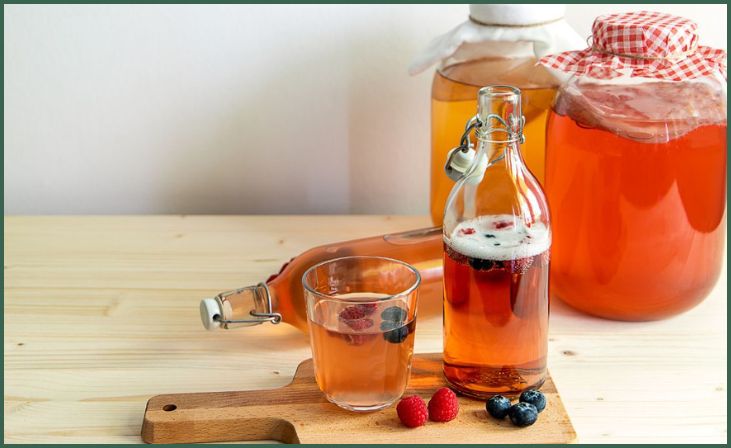
- Boil 4 cups of water and add 4-6 black tea bags along with 1 cup of sugar.
- Let the tea steep for 15-20 minutes to achieve a strong brew.
- Take the tea bags out of the sweet tea and let it cool down some.
Step 2: Add Chai Spices
- Prepare a blend of chai spices, including cinnamon sticks, cardamom pods, cloves, and ginger.
- Add the chai spices to the cooled sweet tea and let it infuse for an additional 20-30 minutes, adjusting the intensity to your taste preference.
Step 3: Strain the Chai Infused Tea
- Use a fine-mesh strainer or cheesecloth to strain out the chai spices, ensuring a smooth liquid base for the Kombucha.
Step 4: Introduce the Starter Liquid and SCOBY

- Pour a portion of matured Kombucha liquid into the jar as the starter.
- Gently place the SCOBY (Symbiotic Culture of Bacteria and Yeast) into the jar with the chai-infused sweet tea.
Step 5: Initiate the Fermentation Process
- Cover the jar with a breathable cloth or paper towel secured with a rubber band.
- Put the jar somewhere warm and airy that isn’t in direct sunlight.
- Allow the Kombucha to ferment for 7-14 days, depending on the desired flavor intensity.
Step 6: Monitor the Fermentation Progress
- Check the taste and acidity level of the Kombucha regularly using a straw or a clean spoon.
- Ensure the chai flavor is infused to your liking without overpowering the natural tanginess of the Kombucha.
Step 7: Bottle and Store
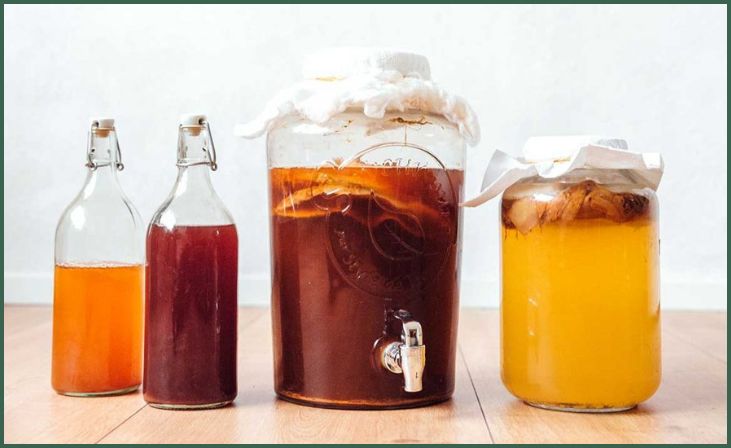
- Once the desired flavor is achieved, carefully remove the SCOBY from the jar.
- Pour the Chai-flavored Kombucha into airtight bottles, leaving some space at the top for carbonation.
- Seal the bottles tightly and store them at room temperature for 1-3 days for secondary fermentation.
Step 8: Refrigerate and Enjoy
- After the secondary fermentation, refrigerate the Chai-flavored Kombucha to halt the fermentation process.
- Serve chilled and savor the delightful combination of tangy Kombucha and aromatic chai spices.
Also Read: Homemade Grape Soda
Don't just scroll, subscribe!
BuzzTrail's unique web-stories are the cure for boredom you've been waiting for.
Tips For Beginners To Make Kombucha at Home
Here are some helpful tips for beginners looking to make Kombucha at home:
- Start with a Basic Recipe: Begin with a simple Kombucha recipe using black or green tea, which is easier to manage for beginners.
- Ensure Cleanliness: Maintain a clean and sanitized environment when brewing Kombucha to prevent contamination and the growth of harmful bacteria.
- Use Quality Ingredients: Opt for high-quality tea and organic sugar to provide the best nutrition for your SCOBY and yield a superior-tasting Kombucha.
- Monitor Temperature: Maintain a consistent brewing temperature between 75-85°F (24-29°C) to facilitate the fermentation process and achieve the best results.
- Be Patient: Allow the Kombucha to ferment for the recommended time without rushing the process, as this will ensure the development of the desired flavor and beneficial properties.
- Taste Regularly: Check the taste of your Kombucha throughout the fermentation process to understand how the flavor evolves and to determine the optimal fermentation duration.
- Protect Your SCOBY: Handle the SCOBY (Symbiotic Culture of Bacteria and Yeast) with clean hands and avoid exposing it to extreme temperatures or direct sunlight.
- Experiment with Flavors: After mastering the basic Kombucha recipe, try incorporating various fruits, herbs, and spices to create unique flavor combinations and expand your brewing repertoire.
- Maintain a Brewing Journal: Keep a brewing journal to record your brewing process, including ingredients used, fermentation times, and flavor experiments. This will help you track your progress and replicate successful batches.
- Research and Learn: Continuously educate yourself about the Kombucha brewing process through reliable sources, books, and online communities to enhance your understanding and skills.
Following these tips will not only help beginners make Kombucha successful but also ensure a smooth and enjoyable brewing experience.
10 Reasons to Make Continuous Brew Kombucha
Here are 10 reasons to make continuous brew Kombucha that you must know after learning how to make Kombucha:
- Time Efficiency: Continuous brewing reduces the need for frequent batch preparations, saving time and effort in the long run.
- Consistent Supply: Maintain a steady and reliable flow of freshly brewed Kombucha without interruptions, ensuring a constant supply for regular consumption.
- Enhanced Flavor Development: Continuous brews allow for a more robust and complex flavor profile due to the extended fermentation time, resulting in a more refined and mature taste.
- Simplified Brewing Process: Eliminate the need for repetitive batch handling and bottling by streamlining the brewing process through a single vessel, making it easier for beginners and experienced brewers alike.
- Reduced Risk of Contamination: With proper maintenance and hygiene, the continuous brew system minimizes the risk of contamination and mold growth compared to repeated batch brewing.
- Health Benefits: Regular consumption of Kombucha supports gut health, aids digestion, and boosts the immune system, promoting overall well-being.
- Cost-Effectiveness: Continuous brewing is a cost-effective approach as it reduces the need for additional brewing equipment and supplies, making it a budget-friendly option in the long term.
- Sustainable Brewing Practice: By reusing the SCOBY and maintaining a continuous brew system, you contribute to sustainable brewing practices, minimizing waste and resource consumption.
- Customizable Fermentation: Control the flavor intensity and acidity levels of your Kombucha by monitoring and adjusting the fermentation process to cater to personal taste preferences.
- Brewing Versatility: Experiment with various flavors and ingredients, including fruits, herbs, and spices, to create a diverse range of Kombucha flavors using the continuous brew method, allowing for creative exploration and customization.
Considering these reasons, you can appreciate the benefits of continuous brew Kombucha, making it an appealing and practical choice for brewing this beloved fermented beverage at home.
Also Read: How to Make Ginger Bug
Conclusion
In conclusion, crafting your own Kombucha at home not only offers a satisfying creative outlet but also provides a healthy and delicious addition to your daily routine. With its myriad of health benefits and the flexibility to customize flavors, making Kombucha can be a rewarding and enjoyable experience. By following the simple steps outlined in this guide, you can embark on a flavorful journey while reaping the many nutritional rewards of this ancient fermented beverage.
FAQs
How long does it take to make Kombucha?
How long does it take to make Kombucha?
The fermentation process typically takes around 7 to 14 days, depending on your taste preferences and the ambient temperature.
Can I use flavored tea to make Kombucha?
Can I use flavored tea to make Kombucha?
Yes, you can experiment with different types of flavored tea to infuse unique taste profiles into your Kombucha. However, ensure that the tea does not contain oils or additives that might hinder the fermentation process.

